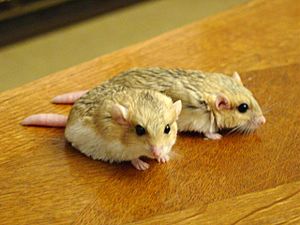Gerbil facts for kids
Quick facts for kids GerbilTemporal range:
late Miocene - Recent |
|
|---|---|
 |
|
| Scientific classification | |
| Kingdom: | |
| Phylum: | |
| Class: | |
| Order: | |
| Suborder: | |
| Superfamily: | |
| Family: | |
| Subfamily: |
Gerbillinae
Gray, 1825
|
Gerbils are small, furry rodents. There are about 110 different kinds, or species, of gerbils. They are known for living in dry places like deserts. Because of this, people sometimes called them "desert rats."
Most gerbils are active during the day. Some are active at dawn and dusk. Gerbils come from places like Central Asia, India, the Middle East, and Africa.
A typical gerbil is about six to twelve inches long. This measurement includes its tail, which is usually half of its total length! Gerbils are also popular pets in many homes.
Some interesting types of gerbils are:
- Fat-tailed gerbil: This gerbil's tail gets thicker when it eats a lot.
- Great gerbil: This is the largest type of gerbil.
The Mongolian gerbil is one of the 110 species. It is the most common type kept as a pet. People first found the Mongolian gerbil in 1800. However, scientists didn't study it until 1866. All pet Mongolian gerbils today come from just a few gerbils found in 1930.
Gerbils are usually smaller than rats but bigger than mice. Their size can depend on the specific species. Unlike mice and rats, gerbils have furry tails that often end with a small tassel. A common gerbil is about 5-6 inches long. With its tail, it can be 11-12 inches long. Bigger gerbils, like the Great gerbil, can have a body and tail each around 7-8 inches long.
Contents
Gerbil Behavior
Gerbils are very social animals. In the wild, they live together in groups, like a family or clan. They use their strong sense of smell to recognize other gerbils in their group.
If you want to introduce gerbils from different families, you need to be careful. A common way is called the "split tank method." This helps them get used to each other's smell slowly. Gerbils are known to attack or even kill other gerbils that smell unfamiliar to them.
Gerbils as Pets
People started keeping gerbils as pets in 1964. The first ones were Mongolian gerbils. Soon, people realized how great they were as pets. Now, you can find them in pet shops all over the United Kingdom and the United States.
However, in the US state of California, it is against the law to buy, bring in, or keep a gerbil as a pet. This is because they could harm the local environment and farms if they escaped into the wild.
Housing Pet Gerbils
When buying a home for pet gerbils, many people think they can live in cages made for hamsters or mice. This is not quite right. Gerbils need space to dig their own tunnels. They don't do well in cages where tunnels are already built for them.
Also, many hamster and mouse cages are made of plastic. Gerbils can chew through plastic very quickly! If they eat plastic, it can make them very sick. Because of this, many gerbil owners avoid plastic toys. They prefer to use wooden toys instead.
The exact size of a gerbil tank can vary depending on different groups. However, a common rule is to have at least 10 imperial gallons (45 L) of space for each gerbil. This gives them enough room to dig and play.
Why Gerbils Are Popular Pets

There are several reasons why gerbils are popular pets:
- Friendly Nature: Gerbils are usually not aggressive. They rarely bite unless they are scared or stressed.
- Easy to Handle: They are small and easy to hold. They also enjoy being around humans and other gerbils.
- Very Clean: Gerbils are very clean animals. Their bodies are good at saving water, so they don't produce much waste. This means they have very little odor.
Images for kids
-
Wilhelma Zoo, Stuttgart, Germany
See also
 In Spanish: Gerbil de Mongolia para niños
In Spanish: Gerbil de Mongolia para niños


















